 Bunnik municipality / Gemeente Bunnik (U) Municipality covering part of the area south-east of the city of Utrecht and named after its largest village and administrative center. The municipality also encompasses the villages Werkhoven and Odijk. Gemeente die een deel van het gebied ten zuid-oosten van de stad Utrecht beslaat en is vernoemd naar zijn grootste dorp en administratief centrum. De gemeente omvat ook de dorpen Werkhoven en Odijk. |
| Bunnik
The reformed church of Bunnik until the Reformation was known as the St. Nicolaas. The church consists of a tower and a one-aisled nave, both of which date probably from the 13th century, and a choir which partly dates from 1566. Location: Kerkpad 2 De hervormde kerk van Bunnik was tot de Reformatie bekend als de St. Nicolaas. De kerk bestaat uit een toren en een eenbeukig schip, die beide waarschijnlijk uit de 13e eeuw stammen, en een koor dat deels dateert uit 1566. Locatie: Kerkpad 2
|
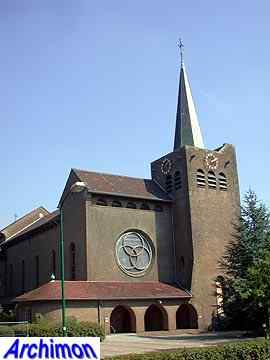 The Roman Catholic St. Barbara dates from 1939. It is one of only a very few buildings designed by architect A.J.N. Boosten that were built outside his native province of Limburg. The church is a typical example of Boosten's style. Location: Stationsweg 36 De rooms-katholieke St. Barbara dateert uit 1939. Het is een van slechts een zeer beperkt aantal werken naar ontwerp van architect A.J.N. Boosten die gebouwd werden buiten zijn eigen provincie Limburg. De kerk is een typisch voorbeeld van Boosten's stijl. Locatie:
Stationsweg 36 |
| Odijk
Location: Zeisterweg 34 De Hervormde kerk van Odijk is het restant van een grote gotische kerk. In 1820 werd de kerk gesloopt, behalve het koor dat een gevel en een kleine klokkentoren kreeg en werd bedekt met een laag wit pleisterwerk. Omdat Odijk een overwegend katholiek dorp was, was een kleine kerk groot genoeg voor de kleine protestantse gemeenschap. Locatie: Zeisterweg 34
|
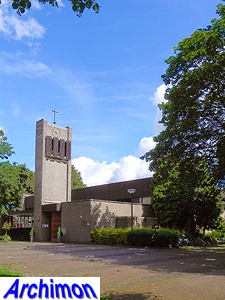 The catholic St. Nicolaas is a modern church which is of no architectural significance, other than being the last church by architect J. van Dongen. It's an aisleless church in an almost Functionalist style and was built in 1964. Location: Sint Nicolaaslaan 1 De katholieke St. Nicolaas is een moderne kerk zonder architectonisch belang, behalve dat het de laatste kerk van architect J. van Dongen is. Het is een zaalkerk in een bijna functionalistische stijl en werd gebouwd in 1964. Locatie: Sint Nicolaaslaan 1 |
Werkhoven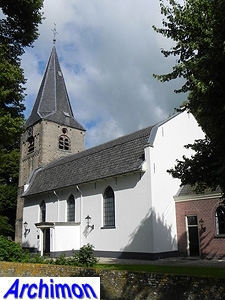 The Reformed church is an originally Romanesque aisleless church which underwent many changes since it was built in the 12th century. The tower was added in ca. 1200 and is still in its original style. Location: Brink 5 De Hervormde kerk is een in oorsprong romaanse zaalkerk die sinds de bouw in de 12e eeuw drastisch is gewijzigd. De toren werd toegevoegd in ca. 1200 en is nog in de originele stijl. Locatie: Brink 5 |
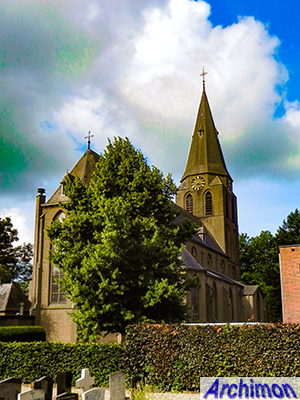 The catholic O.L.V. Maria Hemelvaart is a three-aisled basilica in neo-Gothic style, designed by W. te Riele and built in 1908. Location: Herenstraat 9 De katholieke O.L.V. Maria Hemelvaart is een driebeukige basiliek in neogotische stijl, door W. te Riele ontworpen en gebouwd in 1908. Locatie: Herenstraat 9 |
 The
Augustine priory Gods Werkhof was built in 1959-1960 and was designed by J. Drummen
and P. Vos in a modern Traditionalist style. It was the last enclosed convent
built in the Netherlands. The
Augustine priory Gods Werkhof was built in 1959-1960 and was designed by J. Drummen
and P. Vos in a modern Traditionalist style. It was the last enclosed convent
built in the Netherlands. Location: Hollendewagenweg 20 De Augustinessenpriorij Gods Werkhof werd gebouwd in 1959-1960 en werd ontworpen door J. Drummen en P. Vos in een moderne traditionalistische stijl. Het was het laatste slotklooster dat in Nederland is gebouwd. Locatie: Hollendewagenweg 20 |
|
|
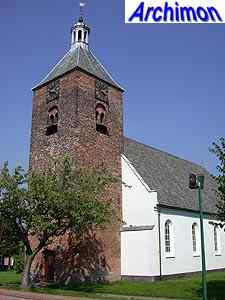
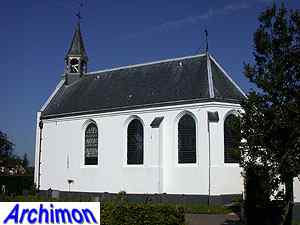 The
The